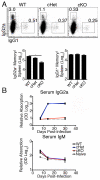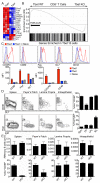Cutting Edge: B Cell-Intrinsic T-bet Expression Is Required To Control Chronic Viral Infection
- PMID: 27430722
- PMCID: PMC4975981
- DOI: 10.4049/jimmunol.1500368
Cutting Edge: B Cell-Intrinsic T-bet Expression Is Required To Control Chronic Viral Infection
Abstract
The role of Ab and B cells in preventing infection is established. In contrast, the role of B cell responses in containing chronic infections remains poorly understood. IgG2a (IgG1 in humans) can prevent acute infections, and T-bet promotes IgG2a isotype switching. However, whether IgG2a and B cell-expressed T-bet influence the host-pathogen balance during persisting infections is unclear. We demonstrate that B cell-specific loss of T-bet prevents control of persisting viral infection. T-bet in B cells controlled IgG2a production, as well as mucosal localization, proliferation, glycosylation, and a broad transcriptional program. T-bet controlled a broad antiviral program in addition to IgG2a because T-bet in B cells was important, even in the presence of virus-specific IgG2a. Our data support a model in which T-bet is a universal controller of antiviral immunity across multiple immune lineages.
Copyright © 2016 by The American Association of Immunologists, Inc.
Figures




References
-
- Virgin HW, Wherry EJ, Ahmed R. Redefining chronic viral infection. Cell. 2009;138:30–50. - PubMed
-
- Walker LM, Phogat SK, Chan-Hui PY, Wagner D, Phung P, Goss JL, Wrin T, Simek MD, Fling S, Mitcham JL, Lehrman JK, Priddy FH, Olsen OA, Frey SM, Hammond PW, Kaminsky S, Zamb T, Moyle M, Koff WC, Poignard P, Burton DR. Broad and potent neutralizing antibodies from an African donor reveal a new HIV-1 vaccine target. Science. 2009;326:285–289. - PMC - PubMed
-
- Bergthaler A, Flatz L, Verschoor A, Hegazy AN, Holdener M, Fink K, Eschli B, Merkler D, Sommerstein R, Horvath E, Fernandez M, Fitsche A, Senn BM, Verbeek JS, Odermatt B, Siegrist CA, Pinschewer DD. Impaired antibody response causes persistence of prototypic T cell-contained virus. PLoS Biol. 2009;7:e1000080. - PMC - PubMed
Publication types
MeSH terms
Substances
Grants and funding
LinkOut - more resources
Full Text Sources
Other Literature Sources
Molecular Biology Databases

